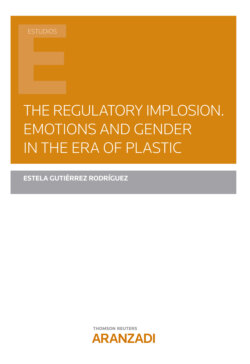Читать книгу The Regulatory Implosion. Emotions and Gender in the Era of plastic - Estela Gutiérrez Rodríguez - Страница 6
На сайте Литреса книга снята с продажи.
Оглавление1
Introduction
“Each one should be asked what is within their reach”.
Antoine de Saint-Exupéry
(1900-1944)
1.1. The purpose of the book
This is a book of global law to human security.
Law that requires collaboration between sciences, was born to guarantee human security in a holistic way, in order to give responses to the situations of changing environments, the same ones that accompany the emerging globalization of demanding societies.
This makes it exciting, to the book and to the form of law.
The first part of the book focuses on explaining what are the chemical substances known as endocrine disruptors (EDC for its acronym in English Endocrine Disrupting Chemicals), as well as very briefly what is the global framework for their regulation1.
We will take into account their worldwide repercussion, since they are a set of substances of a chemical nature that have a harmful effect on any living organism, being capable of causing hormonal alterations, affectations to the immune system, cancer, genetic dysfunctions, causing urogenital malformations, other dysfunctions and diseases of the male and female reproductive system, as well as dermatological problems and even neurological problems at the cognitive level, among many others.
The reason is that hormones are involved in both sexual differentiation and the coordination of various organs and many other processes in the human organism. In this sense, the most concerning issue, is that although some EDC have been analyzed and the use of some of them have been restricted for years, the scope and long-term impact of the so-called “cocktail” or mixture of these multiple substances that affect both, the environment, as well as the human organism around the world, has not been tested yet2.
The so-called endocrine disrupting, also known as environmental estrogens, phytoestrogens or environmental hormones, artificially supplant natural hormones, altering the functions that they must perform in organisms. As we will see, are found in each of our daily routines, so human exposure is extremely high and worrisome.
EDC can be present for example, in containers for food, whether they are lunch boxes, bottles, tableware, in clothing and footwear accessories, in cosmetic and perfumery products, for example in common nail polish, in incense, moisturizing cream or shower gel, in make-up, in children’s and sex toys, feeding bottles, pacifiers, in construction materials, in soda cans, in neonatal intensive care units, can be found in the bags containing products related to blood (platelets, red blood cells, etc.), and even in the tubes that transport these fluids and oxygen, in resins for dental aesthetics, in pesticides applied in fruit cultivation, in insecticides, or in the combustion of the vehicles with which we live daily, as well as in so many other places.
These pollutants can reach the blood through the skin, through the digestive tract and even through the respiratory tract and be distributed throughout the body, which is easy to happen given the magnitude of public exposure to these substances. In the case of pregnant women, the problem is more complicated since the fetus will be the main affected.
Our entire ecosystem is in serious danger, considering that, the exposure to EDC is indiscriminate, massive, continuous and global3.
In the second part and among the objectives of these pages, we will see how the cross-sectional study of different academic disciplines alerts the public system of cost overruns, due to health disorders such as cancer, diabetes, obesity, difficulties in reproduction, cognitive dysfunctions, among other disorders all dependent on the endocrine system, and affected due to both, massive and prolonged exposure over time of citizens to these substances.
Likewise, and do not miss these chapters, the hypothesis of how prolonged exposure to these substances is leading us to a transformation in the human gender and emotions is presented. Indeed, evidence of connections is shown between exposure to hormone disrupting chemicals and gender, emotional, and behavioral differentiation in the human species. Both factors that will determine future global economies and societies.
Then, for the first time in the science of law, the theory called “regulatory implosion to global security” is exposed. This legal institution is framed as one of the “paradoxes of regulation”4. In this sense, we will see how public policies and regulations, are based on both hard law and soft law.
It happens that when different external pressures give rise over the capture of the regulator by the regulated, the particular interest over the general interest, and the individual to the community, the consequences are reflected in the current social and climate (in) justice.
Likewise, the birth of the discipline “ethology of global law” is presented, born to respond to the needs of global administrative law in the immediate future. The ethology of law merges the study of human behavior in the environment, applying the observation of medical and economic sciences, in this way it can be detected ex ante the needs and behaviors of world societies, advancing regulation of disorders that may arise, regulate preventively and thus improve investment in public spending.
1. Vid; Sushil Khetan, Endocrine disruptors in the environment, New Jersey, U.S.A: Edit. Wiley, 2014.
2. A cocktail or mixture is understood to be the set of chemical substances that, acting individually, are known to have the potential capacity to negatively affect people’s health. However, it themselves, acting together, have not yet been evaluated, so the long-term impact it may have on the human body is unknown. See; Andreas Kortenkamp, Michael Faust, 2018. “Regulate to reduce chemical mixture risk”, Science, Vol. 361 (6399): 224-226, doi: 10.1126. https://science.sciencemag.org/content/361/6399/224/tab-pdf.
3. Werner Brack, “Effect-directed analysis of complex environmental contamination”. Edit. Springer Berlin Heidelberg, Germany, 2011.
4. Cass R. Sunstein. The Revolution Rights: Redefining the Regulatory State. Edit. Ramón Areces University. (Madrid, 2016).
